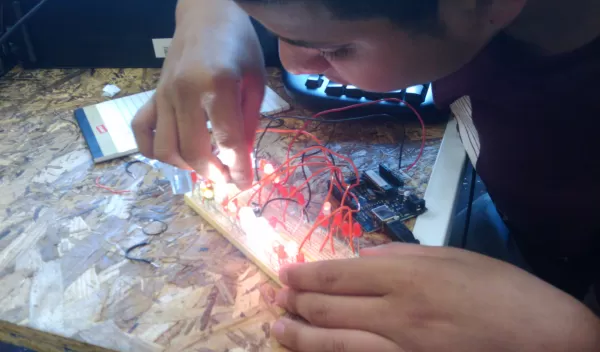
Computer Scientists Bring Digital World to Bronx Kids
Growing up, I was always very good at using computers, but I never really understood how they worked. Until I began my undergraduate studies at the Massachusetts Institute of Technology (MIT), I never made the connection between what happens inside a desktop computer and what happens inside other everyday electronic devices. I didn't know what micro-controllers were, or how they've been used in TV remotes, MP3 players, cell phones, space shuttles, medical devices and, of course, personal computers.
Now, I help teach embedded electronics (also known as physical computing) and digital fabrication to high school students in the South Bronx section of New York City. Going to school in one of the country's poorest congressional districts, the students who participate in the NSF-funded GreenFab program have had no shortage of obstacles to their academic success. Despite these challenges, we don't doubt for a moment that we can teach our students advanced technical concepts, and inspire many of them to pursue careers in green technology and engineering.
Although I now have a better understanding of embedded processing and enjoy teaching physical computing and digital fabrication to our students, I still have vivid memories of what it felt like to be completely in the dark. The late science fiction author Arthur C. Clarke once said, "Any sufficiently advanced technology is indistinguishable from magic." If that's the case, then I felt during my first year at MIT that the engineers and scientists I met were indistinguishable from sorcerers. Some of the projects that were underway in Neil Gershenfeld's Center for Bits and Atoms research group (also NSF funded) included nuclear magnetic resonance (NMR) quantum computing, inertial measurement devices, liquid computers, new internet protocols for household objects and the creation of low-cost digital fabrication laboratories around the world.
Involvement with the latter project, called FabLabs, is what led me to work for Sustainable South Bronx and Vision Education & Media to teach kids. FabLabs began as an outreach project from the Center for Bits and Atoms (CBA) group. They have a mission to provide widespread access to Computer Numerically Controlled (CNC) fabrication equipment and other modern tools for invention. An international network of FabLabs is currently evolving, with activities ranging from youth technology enrichment programs to the incubation of small-scale, high-tech businesses.
Working with FabLab tools during my undergraduate research at MIT was actually more helpful in demystifying how things are made and how things work than the introductory electrical engineering and computer science classes I took before I switched my major to mathematics. Those introductory classes focused heavily on first principles and abstract concepts, postponing hands-on work until a theoretical framework was learned. FabLabs take the opposite approach. You learn concepts as they become necessary. FabLabs provide a great opportunity to make engineering and science hands-on for kids, rather than remote and abstract.
Since the program began this past February, there is one student who stands out as an example. At first, Jose was somewhat of a challenging student to work with. Obviously a bright kid but without a lot of energy, he wasn't always able to maintain focus and attention on any particular task. He saw everything as complicated and difficult, often giving up very early. Jose made a noticeable transformation during this past summer session, after building a DIY (do-it-yourself) robot project from scratch. I told Jose and a few other students to look up the Arduino SERB robot, which could be made from scratch using equipment and parts that we either had in the lab or could easily obtain.
Jose found a great tutorial on Instructables.com on how to put the robot together. With a minimal amount of supervision, he was able to finish the project and even add his own variation. He wanted the robot to be controlled by a Nintendo Wii ™ "nunchuck" controller, which uses an accelerometer to control a gaming interface. Taking his own initiative, he researched how to "hack" the Wii controller to have it interface with the SERB robot.
Jose is currently a senior in high school and has expressed a strong desire to pursue an engineering degree at the New York State University at Buffalo, citing GreenFab as a motivating factor in his career ambitions.
At the very least, we hope that when the students complete our program, they will have acquired independent learning skills and a penchant for questioning how things work. This might lead to questioning how other complicated systems work, such as urban politics, development and infrastructure. GreenFab could lead them to ask questions like, "Why are there fewer Green Spaces in the South Bronx than in the West Village?," "Why does the city want to build more prisons and waste handling facilities in my neighborhood?," or "Saving polar bears is cool and everything, but can the 'green' movement actually help me earn a decent living?"
-- Jonathan Santiago, STEM2GETHER
This Behind the Scenes article was provided to LiveScience in partnership with the National Science Foundation.


